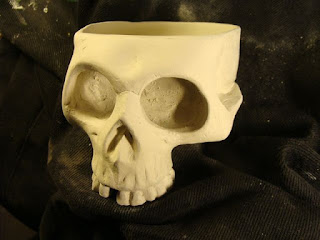Friday, February 22, 2013
Tuesday, February 5, 2013
Ceramics in progress
Yorik
slipcast greenware,
border of thinness (cranium c. 5mm--maybe a bit extreme?)
Moon
stained bisque
stain: thin sort metal glaze, half normal to half water
Borgnine
bisque
sort metal pensel glasur on eyebrows was thinly applied to greenware before firing
Saxeehuaman
bisque fired
two layers sort metal pensel glasur applied in two coats to bisque
plaster engraving for embossed stamp for press molded pieces
Olmec original
greenware
stained sort metal glaze dripped and wiped to greenware before firing.
This suffered ruination, typical to the process of ripping the original clay model from a two-pieced plaster mold. Nonetheless, it is interesting, a natural ruination that one would see in a real Olmec head, thousands of years old.
Side view.
ripped-off layer reveals the additive process of making models from clay (as opposed to the preferred way of sculpting them from plaster.) Clay affords additive as well as subtractive sculpting. If something has to give when prizing apart the mold halves, the model breaks--preferable to the plaster mold, I think.
Brain
bisque
stain of half transparent/half bordeaux glaze was thickly dipped and wiped. hard to see color before firing.
Olmec
greenware
Press-molded, two halves built.
When mold is wet after casting it, I like to press mold it to test it. It will take days for the mold to be dry enough for the slip casting process.
front view
Olmec
slip cast greenware--finally!
This casting is extremely thick, having sat overnight (no slip left to pour out!) I did this because I was so tired of wasting hours, ripping a too-thin and wet casting to pieces. It worked out--though obviously next time I need more patience, waiting a good several days for the plaster to dry and become porous enough to suck slip properly.

Side view.
Accidental ruination behind the seam--somehow it looks natural. It was due to a mishap, when the plaster leaked into the other, nonexistent half of the mold. I managed to save the whole project by just pouring the second half later, the accidental plaster fuzing to the intentional mold half.
Coffee Cup
Greenware
Press molded from two mold halves.
The shape of the cup might be conical enough for a one-piece drop mold--but the beans probably have too many undercuts even so. After the trials in the jungle of the Olmecs, I didn't want to press my luck, so I opted for a two-piece, with a built handle.
Subscribe to:
Posts (Atom)













